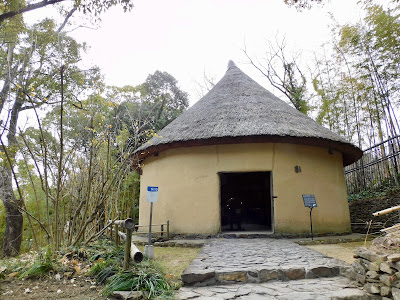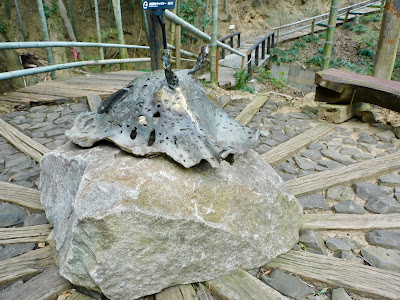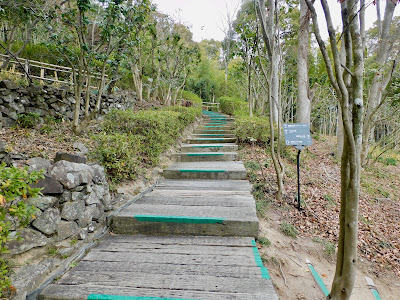 |
| 結婚10周年アートの旅 2023年2月6-12日 2月14日が私達の結婚記念日、私と夫Rは "結婚10周年アートの旅" をしました。 このセクションは主に四国村 (シコクムラ) ; ⑩⑫⑬⑱についてです。 10th Wedding Anniversary Art Trip, 6th of February 6th -12th of February 2023 February 14th was our wedding anniversary, and my husband R and I had a "10th wedding anniversary art trip". This section is mainly about Shikoku Mura ; ⑩⑫⑬⑱. |
 |
| 案内マップ / Guide Map 画像は下記より / This from below ★ |
 |
| ⑩冨木田家砂糖しめ小屋 / Fukita Family Sugar Cane Press ⑫六車家釡屋 / Muguruma Family Furnace Hut ⑬宮崎家砂糖しめ小屋 / Miyazaki Family Sugar Cane Press ⑱茶堂「遊庵」/ Tea Hall "Yuan" |
 |
可愛らしい形です。 ドワーフが住んでいるような気がします。 It has a cute shape. It feels like a place where dwarves live. |
 |
| しっかりしつつ、綺麗な骨組みの屋根です。 It is a sturdy roof with a beautiful framework. |
 |
| 窓からの景色 明かり取りなのか、換気のためなのか、窓があります。 View From the Window There is a window, perhaps for light or ventilation. |
 |
⑩冨木田家砂糖しめ小屋 後日、自分の写真にこの展示に対する案内板が 写っていることに気がつきました。 案内板は入り口、左側にありました。 ⑩Fukita Family Sugar Cane Press Later, I noticed that the information board for this exhibition was captured in my photograph. The information board was located on the left side of the entrance. tk 15 : 作品番号 作品名 : "Suitcase in a Bottle, 2019" 'Cultural refugee' : '文化難民' ; サブタイトル 表 題:漂流する人々の心情を スーツケースやボトルのモチーフで表現。 tk 15 : Work number Work's Title : "Suitcase in a Bottle, 2019" 'Cultural refugee' As for the title ; the motif is a suitcase and a bottle, expressing the feelings of people adrift. "Suitcase in a Bottle, 2019" ラム・カツィール/ Ram Katzir (? ~ ) 作 "瀬戸内海芸術祭2019"に展示されました。 当時は、①かずら橋の池に浮かんで(?) 展示されていました (下の写真) が、 今 (2023年2月6日)は、ここにあります。 "Suitcase in a Bottle, 2019" By Ram Katzir (? ~ ) Exhibited at the Seto Inland Sea Art Festival 2019. At the time, it was exhibited floating(?) in the ① Kazura-bashi Bridge pond, below, but now (6th of February, 2023) it is here. |
 |
| "Suitcase in a Bottle, 2019" 展示は、こちらの方が面白く、インパクトがありますね。 展示作業はこちら→★ : なかなか興味深い作業です。 "Suitcase in a Bottle, 2019" The exhibit here was more interesting and had more impact. The display process can be found here→★ only in Japanese, but you can see some photographs. It's quite an interesting process. 画像は下記より/ This from below ★ |
 |
| ⑬宮崎家砂糖しめ小屋 ⑬Miyazaki Family Sugar Cane Press   |
 |
| "しめぐるま" この地方では、"しめぐるま"と呼ばれますが、 他の地では、"砂糖車 (サトウグルマ)"と呼ばれます。 "Shimeguruma" ; Sugarcane Press In this region, it is called "Shimeguruma", but in other areas, it is called "Sato-guruma ; Sugar Wheels". |
 |
| "しめぐるま" 構造 ; "牛や馬など畜力で心棒を回転させ、 その運動を歯車で計3連のローラーに伝える。 回転するローラーの間にサトウキビの茎を差し込んで 圧迫粉砕し、搾り出した汁を煮詰めて砂糖に加工した。" (Wikiより) Structure of Sugarcane Press According to Wiki about structure of the Press, (translated by me) "The mandrel is rotated by the power of animals such as cows or horses, and the motion is transmitted to a total of three rollers via gears. The sugarcane stalks are inserted between the rotating rollers and crushed under pressure, and the juice that is squeezed out is boiled down and processed into sugar". |
 |
| 19世紀、徳之島(奄美群島のほぼ中央にある離島)の 木製サトウキビ搾り機 A wooden sugarcane press from Tokunoshima Island (a remote island located almost in the centre of the Amami Islands) in the 19th century 画像は下記より / This from below ★ |
 |
下記、サイトより引用 "砂糖しめ小屋でしぼったサトウキビの汁を、3つの釜で 煮詰めて、白砂糖の前段階である白下糖をつくり、さらにこれを 精製し白い砂糖が作られました。 その工程の中から讃岐特産の和三盆糖も生まれました。 |
 |
Late 1800s (mid-Meiji period) According to Shikoku Mura website, 'translated by me) "The juice from the sugarcane squeezed out in the sugar-pressing hut was boiled down in three pots to produce shiroshitato, a precursor to white sugar, which was then refined to produce white sugar. The Sanuki Wasanbon product was also created from this process." |
 |
| ⑬宮崎家砂糖しめ小屋の裏 Back of ⑬Miyazaki Sugar Cane Press |
 |
| 手前の屋根が ⑪上原家砂糖しめ小屋、 屋根の向こうに ⑨河野家住宅 、⑦石畳ひろばが見えます。 The roof in the foreground is ⑪Uehara Family Sugar Cane Press, and behind the roof is ⑨Kono Family House and the ⑦Stone Pavement Square. |
 |
水仙 ここの水仙は、ニホンズイセンのようです。 建物だけでなく、植栽にも気を使われています。 民家は、木々や植物が似合います。 Narcissus The narcissuses here seem to be Japanese Narcissuses : Not only the buildings but also the plantings have been given great care. The trees and plants look great amongst the private homes. |
 |
| シロハラ? 登り道の先に、1羽の鳥が現れました。 シロハラでしょうか? Turdus Pallidus? A bird appeared in front of us on our climbing path. Is it a Turdus Pallidus? |
 |
| 見上げると....⑱茶堂「遊庵」? Looking up... ⑱Tea House "Yuan"?  |
 |
| ⑱茶堂「遊庵 これは、"日本のおもてなし"の原点です。 ⑱Tea House "Yuan" This is the origin of "Japanese Omotenashi" : Japanese hospitality. |
The Guide Board says ( translated by me),
"「Cha-do: Tea Hall」is a hall which was built on village borders or mountain passes.
They were once widespread in villages of Shikoku, but very few remain today.
A Buddha is enshrined at the front, and with three open sides, they were used as places of worship, as well as for serving tea to passersby and as a resting place for pilgrims on Shikoku Pilgrimage.
This hall was on the Ryuo Kaidō : Dragon Road that runs from Tosa to Iyo.
The Jizo Bodhisattva was made by sculptor, Masayuki Nagare (1923 - 2018 / he also created "Nagare-zaka Hill, 1976" ).
It was consecrated by a Japanese Buddhist nun, Jakucho Setouchi (1922 - 2021) at the Shikoku Mura Village Opening Ceremony, and was named "Yuan."
I feel people's compassion for strangers and travellers.
"Jakucho Setouchi was a Japanese Buddhist nun, writer, and activist. Setouchi wrote a best-selling translation of The Tale of Genji and over 400 fictional biographical and historical novels.
In 1997, she was honoured as a Person of Cultural Merit, and in 2006, she was awarded the Order of Culture of Japan."
サヌカイトとその類縁岩石は,紀伊半島中部から本県を経て,九州北部までの分布を示し,大阪府の二上山には香川県に分布するものとよく似た岩石が見られます。
 |
| 竹林の道・始め 道脇の竹の合間に、お地蔵様もしくは、小さな仏像が 置かれています。 Bamboo Path・Start There are Jizo statues or small Buddha statues placed between the bamboo at the side of the road. |
 |
| 階段の先 これは何?とまたもや疑問に思うものが現れました。 Beyond the Steps What is this? again something appeared that made me wonder.  "雨降使 ( アメフラシ)" : ★ 作:鋳金家・本山ひろ子 (1975 ~) "雨降使像は、本山氏による "装う神様" シリーズの作品の1つです。 "Amefurashi" ( "Sea Hare" : "Anaspidea") By a metalworker, Hiroko Motoyama (1975~) The "Amefurashi" Statue is one of the works in her "Dressed Up Gods" series.  "雨降使 ( アメフラシ)" このお話は、本山氏が創作しました。 英国圏では、アメフラシのことを"海うさぎ/ Sea Hare"と 呼びます。 ドイツの童話 (グリム童話) の中に、'海うさぎ' が登場する話が あり、題名は、『悪魔から隠れるお姫様』です。 そのお話は、このアメフラシの話とは全く違います。 Tale of the "Sea Hare" This story was created by Motoyama. "Amefurashi" in Japanese is called "Sea Hare" in English. There is a story in German Fairy Tales (Grimm's Fairy Tales) in which a 'Sea Hare' appears, and the title is "Hiding from the Devil (Princess)". That story is completely different from the story of this "Sea Hare". |
 |
| アメフラシ 兵庫県豊岡市竹野町の大浦浜にて撮影 Sea Hare Photographed at Ourahama Beach in Takeno-cho, Toyooka City, Hyogo Prefecture in Japan 画像は下記より / This from below ★ |
 |
| 墨を放出する、ジャンボ・アメフラシ (カリフォルニア・アメフラシ) 英語で、'海うさぎ' と呼ばれるのは、 触覚がうさぎの耳を思わせるからなんですね〜。 California Sea Hare Emitting Ink Cloud In English, they are called 'Sea Hare' because their antennae resemble hare ears. 画像は下記より / This from below ★ |



















